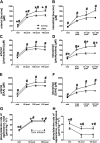Age-related anabolic resistance after endurance-type exercise in healthy humans
- PMID: 20547663
- PMCID: PMC2996901
- DOI: 10.1096/fj.09-150177
Age-related anabolic resistance after endurance-type exercise in healthy humans
Abstract
Age-related skeletal muscle loss is thought to stem from suboptimal nutrition and resistance to anabolic stimuli. Impaired microcirculatory (nutritive) blood flow may contribute to anabolic resistance by reducing delivery of amino acids to skeletal muscle. In this study, we employed contrast-enhanced ultrasound, microdialysis sampling of skeletal muscle interstitium, and stable isotope methodology, to assess hemodynamic and metabolic responses of older individuals to endurance type (walking) exercise during controlled amino acid provision. We hypothesized that older individuals would exhibit reduced microcirculatory blood flow, interstitial amino acid concentrations, and amino acid transport when compared with younger controls. We report for the first time that aging induces anabolic resistance following endurance exercise, manifested as reduced (by ∼40%) efficiency of muscle protein synthesis. Despite lower (by ∼40-45%) microcirculatory flow in the older than in the younger participants, circulating and interstitial amino acid concentrations and phenylalanine transport into skeletal muscle were all equal or higher in older individuals than in the young, comprehensively refuting our hypothesis that amino acid availability limits postexercise anabolism in older individuals. Our data point to alternative mediators of age-related anabolic resistance and importantly suggest correction of these impairments may reduce requirements for, and increase the efficacy of, dietary protein in older individuals.
Figures




Similar articles
-
Muscle protein metabolism responds similarly to exogenous amino acids in healthy younger and older adults during NO-induced hyperemia.Am J Physiol Regul Integr Comp Physiol. 2011 Nov;301(5):R1408-17. doi: 10.1152/ajpregu.00211.2011. Epub 2011 Aug 31. Am J Physiol Regul Integr Comp Physiol. 2011. PMID: 21880862 Free PMC article.
-
Postexercise Dietary Protein Strategies to Maximize Skeletal Muscle Repair and Remodeling in Masters Endurance Athletes: A Review.Int J Sport Nutr Exerc Metab. 2016 Apr;26(2):168-78. doi: 10.1123/ijsnem.2015-0102. Epub 2015 Sep 24. Int J Sport Nutr Exerc Metab. 2016. PMID: 26402439 Review.
-
Aging differentially affects human skeletal muscle microRNA expression at rest and after an anabolic stimulus of resistance exercise and essential amino acids.Am J Physiol Endocrinol Metab. 2008 Dec;295(6):E1333-40. doi: 10.1152/ajpendo.90562.2008. Epub 2008 Sep 30. Am J Physiol Endocrinol Metab. 2008. PMID: 18827171 Free PMC article. Clinical Trial.
-
Skeletal muscle LINE-1 ORF1 mRNA is higher in older humans but decreases with endurance exercise and is negatively associated with higher physical activity.J Appl Physiol (1985). 2019 Oct 1;127(4):895-904. doi: 10.1152/japplphysiol.00352.2019. Epub 2019 Aug 1. J Appl Physiol (1985). 2019. PMID: 31369326
-
Protein Requirements for Master Athletes: Just Older Versions of Their Younger Selves.Sports Med. 2021 Sep;51(Suppl 1):13-30. doi: 10.1007/s40279-021-01510-0. Epub 2021 Sep 13. Sports Med. 2021. PMID: 34515969 Free PMC article. Review.
Cited by
-
Cardiovascular aging and the microcirculation of skeletal muscle: using contrast-enhanced ultrasound.Am J Physiol Heart Circ Physiol. 2018 Nov 1;315(5):H1194-H1199. doi: 10.1152/ajpheart.00737.2017. Epub 2018 Aug 3. Am J Physiol Heart Circ Physiol. 2018. PMID: 30074839 Free PMC article.
-
Altered muscle oxidative phenotype impairs exercise tolerance but does not improve after exercise training in multiple sclerosis.J Cachexia Sarcopenia Muscle. 2022 Oct;13(5):2537-2550. doi: 10.1002/jcsm.13050. Epub 2022 Aug 4. J Cachexia Sarcopenia Muscle. 2022. PMID: 35929063 Free PMC article. Clinical Trial.
-
Exercise-induced gene expression changes in skeletal muscle of old mice.Genomics. 2021 Sep;113(5):2965-2976. doi: 10.1016/j.ygeno.2021.06.035. Epub 2021 Jun 30. Genomics. 2021. PMID: 34214629 Free PMC article.
-
Growing older with health and vitality: a nexus of physical activity, exercise and nutrition.Biogerontology. 2016 Jun;17(3):529-46. doi: 10.1007/s10522-016-9637-9. Epub 2016 Feb 15. Biogerontology. 2016. PMID: 26878863 Free PMC article. Review.
-
The effects of resistance exercise training on macro- and micro-circulatory responses to feeding and skeletal muscle protein anabolism in older men.J Physiol. 2015 Jun 15;593(12):2721-34. doi: 10.1113/JP270343. Epub 2015 May 14. J Physiol. 2015. PMID: 25867865 Free PMC article. Clinical Trial.
References
-
- Paddon-Jones D., Short K. R., Campbell W. W., Volpi E., Wolfe R. R. (2008) Role of dietary protein in the sarcopenia of aging. Am. J. Clin. Nutr. 87, 1562S–1566S - PubMed
-
- Johnston A. P., De Lisio M., Parise G. (2008) Resistance training, sarcopenia, and the mitochondrial theory of aging. Appl. Physiol. Nutr. Metab. 33, 191–199 - PubMed
-
- Balagopal P., Rooyackers O. E., Adey D. B., Ades P. A., Nair K. S. (1997) Effects of aging on in vivo synthesis of skeletal muscle myosin heavy-chain and sarcoplasmic protein in humans. Am. J. Physiol. Endocrinol. Metab. 273, E790–E800 - PubMed
-
- Yarasheski K. E., Pak-Loduca J., Hasten D. L., Obert K. A., Brown M. B., Sinacore D. R. (1999) Resistance exercise training increases mixed muscle protein synthesis rate in frail women and men ≥76 yr old. Am. J. Physiol. Endocrinol. Metab. 277, E118–E125 - PubMed
Publication types
MeSH terms
Grants and funding
LinkOut - more resources
Full Text Sources
Medical

